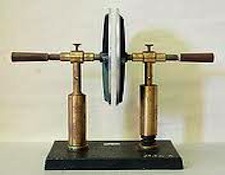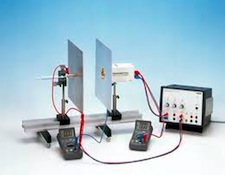It’s the time of year for saving money!

Given the never-ending battle between the “Engineers” and the
“Believers” over whether we can actually hear differences, or if, in the
absence of measurement, double-blind testing, and such, it’s all just “voodoo”,
here’s a story that some of you may find interesting:
When I was just a kid in a High School physics class, I saw a
demonstration of something that, as near as I have been able to determine, is
still not fully explained: The teacher
was talking about capacitors, and explained that a capacitor is an
energy-storage device formed whenever any two conductors (the “plates”) are
separated by any non-conductor (the “dielectric”). When a charge is applied to
either plate, he went on, as long as there is a difference in potential
(voltage) on the plates, the other plate will also charge until the charge
intensity on both plates is equal. Not all of the available charging energy, he
continued, will appear at the plates, however; some portion of it will be
stored, to be released under circumstances that he said he would explain later.
To demonstrate this, he pulled out and set on the demonstration
bench, an odd wood and metal device and a (perhaps12Volt, I simply don’t
remember) battery. The wood-and-metal
thingy consisted of three pieces: (a) two separate four or five inch long
pieces of what looked like broom handle, each centered at one end on a five or
six inch diameter thin piece of metal (that sort of looked like a cut-out tin
can lid) to form (if held vertically) a “T” shaped structure, with the broom
handle piece as the vertical member and the metal piece (the “plate”) as the
cross-member (b) a “U” shaped (but flat-bottomed) wooden structure consisting
of three pieces of (probably) 1 inch thick by
6 inches wide board, arranged as two 5 or 6 inch tall vertical members
mounted at the ends of a similar-length horizontal member. Each of the vertical members of the U-shaped
“mount” had a V-shaped notch cut into its top edge so that one of the
broom-handle pieces could be set across it and held in place, and each of the
broom-handle pieces had been drilled through its long axis so that a wire could
be passed through it and attached to the metal “plate” at its end and the other
end of the wire could be run a couple of feet to an alligator clip for
attachment to the battery.
The final piece of equipment was an “electroscope” – a very
simple test instrument used to test for and indicate the presence of an
electric charge. The particular kind used was a “gold leaf” electroscope,
which, in its least complex form, uses two small pieces of gold leaf fixed to
the end of a conducting rod, with the leaves protected by a glass bell and the
rod projecting beyond the glass to act as the “detector”. When this detector is
brought near or touched to a charged object, electrons will be picked up and
transferred through the rod to the gold leaves which, thus becoming charged
with the same polarity, repel each other and visibly spread apart. When no
charge is present, the leaves just hang limp.

To start the demonstration, the teacher put the two “T-handle”
pieces on the “U” mount so that the handles were horizontal, held in place by
the notched boards, and the two metal plates were facing each other close
together, but not touching – perhaps an eighth of an inch apart. He then, using
the alligator clips at the ends of the wires, attached the two wires coming off
the T-handles to the battery; one wire to the positive (+) terminal and one to
the negative (-) terminal. After a
moment, he disconnected the two alligator clips and, holding them out, asked
the class what we thought would happen if he were to touch them together. When nobody knew, he brought the two clips
together and we were rewarded with an audible “snap” and a clearly visible
spark.
The spark, he said, happened because, when he attached the
wires to the battery, the capacitor charged and continued to hold its charge
even after the wires had been disconnected. When he later touched the wires
together, the capacitor discharged, he said, producing the spark and the sound.
To prove that the capacitor (the two t-handles and the [dielectric] space
between them) was discharged after the spark, he checked it with the
electroscope and, sure enough, the gold leaves showed no movement at all. Then he re-charged the capacitor by
reattaching the wires to the battery, and again disconnecting them, so that
there could be no continuing energy from that source. When he checked the
capacitor again, the leaves of the electroscope sprang wide apart, indicating
the presence of a strong charge.
Then came the really interesting part of the demonstration:
Taking the capacitor apart, he lifted one of the T-handles off the U mount and
checked it by holding the electroscope to its plate, then, handing it to one of
the students, he had the student carry it off to one of the far corners of the
room. Then he did the same thing with the other T-handle – checking its plate
and having another student carry it off to the other far corner of the room.
Finally, he passed the electroscope through the space between the vertical
members of the U mount that had included the (air) dielectric for the
capacitor. None of the three things checked – neither the two plates nor the
space that had been the dielectric – showed any evidence of charge at all, and
when the teacher asked us where we thought the charge had gone, not one of us
had even the slightest clue, although we agreed that it had gone completely.

The teacher then asked the students holding the T- handles to
bring them back and place them back into the U mount in their original
(capacitor) positions. When that was done, he asked us to tell him what we
thought would happen if he, once again, touched the two wires together. We had
all seen that nothing was charged, so naturally we all agreed that nothing
would happen. Imagine our surprise when, touching them together, he got the
same spark and “snap” as before.
What we has just seen, he told us, was one of the great
continuing mysteries of science: We know, he said, that capacitors store
energy; we know that they store it in their dielectric; and, if we know the
dielectric material, its dielectric
constant, and the amounts and voltages involved, we can accurately predict
exactly how much energy they will store. We
even know that the storage involves the electrostatic fields created by the
charging voltages and we know how to calculate them, but despite all that
knowledge, NO ONE, he said HAS ANY IDEA AT ALL WHERE THE MISSING CHARGES WENT
OR HOW THEY GOT THERE!
Now that was half a century ago, and the teacher was only a
high school teacher, and it may be that those mysteries have now been solved –
or may even have been solved back then. Frankly, it doesn’t matter. Regardless
of what the answer is, there’s still a lesson to be learned here: Possibly it’s
that there are things out there that really exist and that we can really use
even if we don’t fully understand them. Possibly it’s that there are things
that we can measure that we don’t understand. Possibly it’s the opposite – that
there are things that, because we don’t understand them, we don’t know how to
properly measure. Possibly it’s something else, entirely. What do you think?






Often we may find that ignorance is 9 tenths of knowledge 🙂
Actually, we must remember this is about charge “potential”; the difference between charges, charge does not reside in one place. Also, the capacitor cannot be considered alone, it is part of the circuit. Therefore the “charge” only exists when the circuit is complete to allow the high potential to migrate to the lower potential. When the plates were too far apart, there wasn’t enough potential to measure, but when they were close enough the potential exceeded the impedance and you got the “transference” of a charge.
Was the electroscope actually touched to the plates, or only held close? The foils on an electroscope will spread apart from electrostatic induction (not requiring contact from the plate to the electroscope, just physical proximity) when the field strength is high enough, but the field strength is given by voltage divided by plate separation distance. When you greatly increase the separation the field strength is greatly decreased, so the electroscope will not show any separation. The charge is the same, but the field strength is decreased. Returning the plates to the original separation returns the field strength to the original, which shows that the charge was the same as before. You would have to do that experiment quickly here on the Gulf coast, the high humidity causes charge to leak away relatively quickly on most days. You can put this explanation together by looking at the Wikipedia entries for capacitance and electroscope, so either your teacher was pulling your leg, or just wasn’t very familiar with electrostatics and the mathematical descriptions of capacitance, charge, voltage, and field strength.